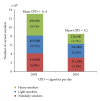Exploring the next frontier for tobacco control: Nondaily smoking among New York City adults
- PMID: 22685481
- PMCID: PMC3363994
- DOI: 10.1155/2012/145861
Exploring the next frontier for tobacco control: Nondaily smoking among New York City adults
Abstract
Objective: Among current smokers, the proportion of Nondaily smokers is increasing. A better understanding of the characteristics and smoking behaviors of Nondaily smokers is needed.
Methods: We analyzed data from the New York City (NYC) Community Health Survey to explore Nondaily smoking among NYC adults. Univariate analyses assessed changes in Nondaily smoking over time (2002-2010) and identified unique characteristics of Nondaily smokers; multivariable logistic regression analysis identified correlates of Nondaily smoking in 2010.
Results: The proportion of smokers who engage in Nondaily smoking significantly increased between 2002 and 2010, from 31% to 36% (P = 0.05). A larger proportion of Nondaily smokers in 2010 were low income and made tax-avoidant cigarette purchases compared to 2002. Smoking behaviors significantly associated with Nondaily smoking in 2010 included smoking more than one hour after waking (AOR = 8.8, 95% CI (5.38-14.27)); buying "loosies" (AOR = 3.5, 95% CI (1.72-7.08)); attempting to quit (AOR = 2.3, 95% CI (1.36-3.96)).
Conclusion: Nondaily smokers have changed over time and have characteristics distinct from daily smokers. Tobacco control efforts should be targeted towards "ready to quit" Nondaily smokers.
Figures
References
-
- Burns DM, Major JM, Anderson CM, Vaughn JW. Smoking and Tobacco Control Monograph 15: Those Who Continue to Smoke. Bethesda, Md, USA: National Cancer Institute; 2003. Changes in cross-sectional measures, numbers of cigarettes smoked per day, and time to first cigarette—California and national data.
-
- Luoto R, Uutela A, Puska P. Occasional smoking increases total and cardiovascular mortality among men. Nicotine & Tobacco Research. 2000;2(2):133–139. - PubMed
-
- Centers for Disease Control and Prevention. Cigarette smoking among adults—United States, 2002. Morbidity and Mortality Weekly Report. 2004;53(20):427–431. - PubMed
Publication types
MeSH terms
Grants and funding
LinkOut - more resources
Full Text Sources
Medical


